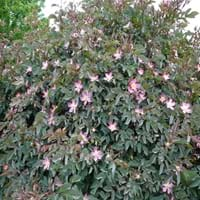Life Span
Perennial
Perennial
Type
Perennial
Flowering Plants
Origin
Eastern Europe
Central Europe, Polynesia, Southern Europe
Types
Not Available
Not Available
Habitat
Terrestrial
Dappled Shade, Sunny Edge, Woodland Garden
USDA Hardiness Zone
4-9
10-15
Sunset Zone
1a, 1b, 2a, 2b, 3a, 3b, 4, 5, 6, 7, 8, 9, 10, 11, 12, 13, 14, 15, 16, 17, 18, 19, 20, 21, 22, 23, 24
H1, H2, 24
Habit
Clump-Forming
Arching/Fountain-shaped
Flower Color
Yellow, Lavender, Blue Violet
Pink
Flower Color Modifier
Bicolor
Bicolor
Fruit Color
Not Available
Red
Leaf Color in Spring
Green, Sea Green
Green, Dark Green
Leaf Color in Summer
Green, Sea Green
Purplish Green
Leaf Color in Fall
Green, Sea Green
Copper
Leaf Color in Winter
Light Green
Blue Green
Leaf Shape
Lanceolate
Pinnate
Plant Season
Spring, Summer
Spring, Summer, Fall, Winter
Sunlight
Full Sun, Partial Sun
Full Sun, Partial Sun
Growth Rate
Medium
Medium
Type of Soil
Loam, Sand
Loam, Sand
The pH of Soil
Neutral
Acidic, Neutral
Soil Drainage
Well drained
Average
Bloom Time
Spring, Late Spring, Early Summer
Early Summer, Summer, Late Summer
Tolerances
Drought
Drought, Salt
Where to Plant?
Ground
Ground, Pot
How to Plant?
By dividing rhizomes, tubers, Seedlings
Seedlings, Stem Planting
Plant Maintenance
Medium
Medium
Watering Requirements
Average Water Needs, Do Not over Water
Requires a lot of watering, Requires regular watering
In Summer
Lots of watering
Lots of watering
In Spring
Moderate
Moderate
In Winter
Average Water
Average Water
Soil pH
Neutral
Neutral, Slightly Acidic, Slightly Alkaline
Soil Type
Loam, Sand
Clay, Loam, Sand
Soil Drainage Capacity
Well drained
Well drained
Sun Exposure
Full Sun, Partial Sun
Full Sun, Partial Sun
Pruning
Remove damaged leaves, Remove dead branches, Remove dead leaves
cut main flower spike, Prune in spring, Remove dead leaves, Remove deadheads
Fertilizers
All-Purpose Liquid Fertilizer
5-10-10 fertilizer
Pests and Diseases
Red blotch
Aphids, Black Spot, Japanese Beetles, Powdery mildew, Spider mites
Plant Tolerance
Drought
Wet Site
Flowers
Yes
Insignificant
Flower Petal Number
Single
Single
Foliage Texture
Coarse
Bold
Foliage Sheen
Matte
Matte
Attracts
Hummingbirds
Bugs
Allergy
Skin irritation
Asthma, contact allergic dermatitis, Rhinoconjunctivitis
Aesthetic Uses
Showy Purposes
Borders, Bouquets, Showy Purposes
Beauty Benefits
Not Available
good for lips, Improve skin tone, Moisturizing, Speed hair growth
Environmental Uses
Air purification
Air purification
Medicinal Uses
No Medicinal Use
anti-inflammatory, Antiseptic, Asthma, Dehydration, Dermatitis, Eczema, Eye Problems, Fatigue, Gallbladder Diseases, Liver problems, Sore throat, Stomach aliments, Swelling, Ulcers, Urinary tract problems
Part of Plant Used
Not Available
Flowers
Other Uses
Used as Ornamental plant
Can be made into a herbal tea, Cosmetics, Culinary use, Edible syrup, Making Sweet Scented Oil, Oil is used for aromatherapy, Used as essential oil, Used as Ornamental plant, Used for fragrance, Used for its medicinal properties
Used As Indoor Plant
No
Yes
Used As Outdoor Plant
Yes
Yes
Garden Design
Alpine, Edging, Mixed Border, Rock Garden, Wall
Bedding Plant, Mixed Border
Botanical Name
IRIS pumila
Rosa glauca
Common Name
Dwarf Iris
redleaf rose, red-leaved rose
In Hindi
Dwarf Iris
red leaved rose
In German
Zwergiris
Rotblatt-Rose
In French
Dwarf Iris
Rosa glauca
In Spanish
Enano Iris
Rosa glauca
In Greek
νάνος Ίρις
Rosa glauca
In Portuguese
Dwarf Iris
Róża czerwonawa
In Polish
Dwarf Iris
Róża czerwonawa
In Latin
Iris Dwarf
Rosa glauca
Phylum
Magnoliophyta
Magnoliophyta
Class
Liliopsida
Magnoliopsida
Family
Iridaceae
Rosaceae
Clade
Angiosperms, Monocots
Angiosperms, Eudicots, Rosids
Tribe
Irideae
Not Available
Subfamily
Iridoideae
Rosoideae
Number of Species
Not Available
Importance of Dwarf Iris and Redleaf Rose
Want to have the most appropriate plant for your garden? You might want to know the importance of Dwarf Iris and Redleaf Rose. Basically, these two plants vary in many aspects. Compare Dwarf Iris and Redleaf Rose as they differ in many characteristics such as their life, care, benefits, facts, etc. Every gardener must at least have the slightest clue about the plants he wants to plant in his garden. Compare their benefits, which differ in many ways like facts and uses. The medicinal use of Dwarf Iris is No Medicinal Use whereas of Redleaf Rose is anti-inflammatory, Antiseptic, Asthma, Dehydration, Dermatitis, Eczema, Eye Problems, Fatigue, Gallbladder Diseases, Liver problems, Sore throat, Stomach aliments, Swelling, Ulcers and Urinary tract problems. Dwarf Iris has beauty benefits as follows: Not Available while Redleaf Rose has beauty benefits as follows: Not Available.
Compare Facts of Dwarf Iris vs Redleaf Rose
How to choose the best garden plant for your garden depending upon its facts? Here garden plant comparison will help you to solve this query. Compare the facts of Dwarf Iris vs Redleaf Rose and know which one to choose. As garden plants have benefits and other uses, allergy is also a major drawback of plants for some people. Allergic reactions of Dwarf Iris are Skin irritation whereas of Redleaf Rose have Asthma, contact allergic dermatitis and Rhinoconjunctivitis respectively. Having a fruit bearing plant in your garden can be a plus point of your garden. Dwarf Iris has no showy fruits and Redleaf Rose has showy fruits. Also Dwarf Iris is flowering and Redleaf Rose is not flowering . You can compare Dwarf Iris and Redleaf Rose facts and facts of other plants too.





